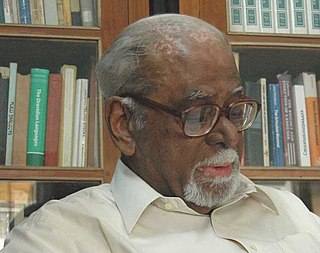Related Research Articles

Brahui is a Dravidian language spoken by some of the Brahui people. The language is spoken primarily in the central part of the Balochistan Province of Pakistan, with smaller communities of speakers scattered in parts of Iranian Baluchestan, Afghanistan, and Turkmenistan and by expatriate Brahui communities in Iraq, Qatar, and the United Arab Emirates. It is isolated from the nearest Dravidian-speaking neighbouring population of South India by a distance of more than 1,500 kilometres (930 mi). The Kalat, Khuzdar, Mastung, Quetta, Bolan, Nasirabad, Nushki, and Kharan districts of Balochistan Province are predominantly Brahui-speaking.

The Dravidian languages are a family of languages spoken by 250 million people, mainly in southern India, north-east Sri Lanka, and south-west Pakistan. Dravidian is first attested in the 2nd century BCE, as inscriptions in Tamil-Brahmi script on cave walls in the Madurai and Tirunelveli districts of Tamil Nadu.

Tamil is a Dravidian language natively spoken by the Tamil people of South Asia. Tamil is an official language of the Indian state of Tamil Nadu, the sovereign nations of Sri Lanka and Singapore, and the Indian Union territory of Puducherry. Tamil is also spoken by significant minorities in the four other South Indian states of Kerala, Karnataka, Andhra Pradesh and Telangana, and the Union Territory of the Andaman and Nicobar Islands. It is also spoken by the Tamil diaspora found in many countries, including Malaysia, Myanmar, South Africa, United Kingdom, United States, Canada, Australia and Mauritius. Tamil is also natively spoken by the Sri Lankan Moors. One of 22 scheduled languages in the Constitution of India, Tamil was the first to be classified as a classical language of India.

The Elamo-Dravidian language family is a hypothesised language family that links the Elamite language of ancient Elam to the Dravidian languages of South Asia. The latest version (2015) of the hypothesis entails a reclassification of Brahui as being more closely related to Elamite than to the remaining Dravidian languages. Linguist David McAlpin has been a chief proponent of the Elamo-Dravidian hypothesis, followed by Franklin Southworth as the other major supporter. The hypothesis has gained attention in academic circles, but has been subject to serious criticism by linguists, and remains only one of several possible scenarios for the origins of the Dravidian languages. Elamite is generally accepted by scholars to be a language isolate, unrelated to any other known language.

The Brahui, Brahvi, or Brohi are an ethnic group of pastoralists principally found in Pakistan, and to a smaller extent in Afghanistan and Iran. They speak Brahui, which belongs to the Dravidian language family.

The Kurukh or Oraon, also spelt Uraon or Dhangad, are a Dravidian speaking ethnolinguistic group inhabiting Chhotanagpur Plateau and adjoining areas - mainly the Indian states of Jharkhand, Odisha, Chhattisgarh, and West Bengal. They predominantly speak Kurukh as their native language, which belongs to the Dravidian language family. In Maharashtra, Oraon people are also known as Dhangad.

Kurukh, also Kurux, Oraon or Uranw, is a Dravidian language spoken by the Kurukh (Oraon) and Kisan people of East India. It is spoken by about two million people in the Indian states of Jharkhand, Chhattisgarh, Odisha, West Bengal, Assam, Bihar and Tripura, as well as by 65,000 in northern Bangladesh, 28,600 of a dialect called Uranw in Nepal and about 5,000 in Bhutan. Some Kurukh speakers are in Andaman and Nicobar Islands. It is most closely related to the Malto language. It is marked as being in a "vulnerable" state in UNESCO's list of endangered languages. The Kisan dialect has 206,100 speakers as of 2011.
Tamil–Kannada is an inner branch of the Southern Dravidian I subfamily of the Dravidian languages that include Tamil, Kannada and Malayalam. There have been slight differences in the way Dravidian languages are grouped by various Dravidian linguists. Tamil–Kannada itself is designated as a branch of the South Dravidian I subfamily and in turn branches off into Tamil–Kota and Kannada–Badaga. The languages that constitute the Tamil–Kannada branch are Tamil, Kannada, Malayalam, Irula, Toda, Kota, Kodava, and Badaga.
Toda is a Dravidian language noted for its many fricatives and trills. It is spoken by the Toda people, a population of about one thousand who live in the Nilgiri Hills of southern India. The Toda language originated from Toda-Kota subgroup of South Dravidian. Krishnamurti (2003) doesnt consider a single Toda-Kota branch and says Kota split first and later Toda did as Kota doesnt have the centralized vowels of other Tamil-Toda languages.
Proto-Dravidian is the linguistic reconstruction of the common ancestor of the Dravidian languages. It is thought to have differentiated into Proto-North Dravidian, Proto-Central Dravidian, and Proto-South Dravidian, although the date of diversification is still debated.
Irula is a Dravidian language spoken by the Irulas who inhabit the area of the Nilgiri mountains, in the states of Tamil Nadu, Kerala, and Karnataka, India. It is closely related to Tamil. It is written in the Tamil script.
The Sholaga (Soliga) language is a Dravidian language related to Kannada and Tamil, spoken by the Soliga people.
Vedic Sanskrit has a number of linguistic features which are alien to most other Indo-European languages. Prominent examples include: phonologically, the introduction of retroflexes, which alternate with dentals, and morphologically, the formation of gerunds. Some philologists attribute such features, as well as the presence of non-Indo-European vocabulary, to a local substratum of languages encountered by Indo-Aryan peoples in Central Asia (Bactria-Marghiana) and within the Indian subcontinent during Indo-Aryan migrations, including the Dravidian languages.
Tamil phonology is characterised by the presence of "true-subapical" retroflex consonants and multiple rhotic consonants. Its script does not distinguish between voiced and unvoiced consonants; phonetically, voice is assigned depending on a consonant's position in a word, voiced intervocalically and after nasals except when geminated. Tamil phonology permits few consonant clusters, which can never be word initial.
MaltoMAL-toh or Pahariapə-HAR-ee-ə, or rarely Rajmahali, is a Northern Dravidian language spoken primarily in East India by the Malto people.

Bhadriraju Krishnamurti was an Indian linguist, specialized in Dravidian languages. He was born in Ongole. He was Vice Chancellor of Hyderabad Central University from 1986 to 1993 and founded the Department of Linguistics at Osmania University where he served as professor from 1962 to 1986. His magnum opus The Dravidian Languages is considered a landmark volume in the study of Dravidian linguistics.

The Dravidian peoples, Dravidian-speakers or Dravidians, are a linguistic and cultural group living primarily in Southern Asia and speaking any of the Dravidian languages. There are around 250 million native speakers of Dravidian languages. Dravidian speakers form the majority of the population of South India and are natively found in India, Pakistan, Afghanistan, Bangladesh, the Maldives, Nepal, Bhutan and Sri Lanka. Dravidian peoples are also present in Singapore, Mauritius, Malaysia, France, South Africa, Myanmar, East Africa, the Caribbean, and the United Arab Emirates through recent migration.

Old Tamil is the period of the Tamil language spanning from 300 BCE to 700 CE and the many regional variations of it including the ones in Kerala. Prior to Old Tamil, the period of Tamil linguistic development is termed as Pre Tamil. After the Old Tamil period, Tamil becomes Middle Tamil. The earliest records in Old Tamil are inscriptions from between the 3rd and 1st century BCE in caves and on pottery. These inscriptions are written in a variant of the Brahmi script called Tamil Brahmi. The earliest long text in Old Tamil is the Tolkāppiyam, an early work on Tamil grammar and poetics, whose oldest layers could be as old as the mid 2nd century BCE. Old Tamil preserved many features of Proto-Dravidian, the earliest reconstructed form of the Dravidian including inventory of consonants, the syllable structure, and various grammatical features.
Standardisation of Tamil script includes various attempts in the past as well as ongoing attempts to uniformalise the Tamil script.
Malaysian Tamil, also known as Malaya Tamil, is a local variant of the Tamil language spoken in Malaysia. It is one of the languages of education in Malaysia, along with English, Malay and Mandarin. There are many differences in vocabulary between Malaysian Tamil and Indian Tamil.